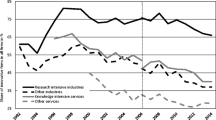Summary
A small step is made in the direction of defining some general basic rules which can serve as a framework for research in several fields of the social sciences. The method of working with analogies asks for a more accurate approach. Starting from the concept of evolution in the form of a basic rule another basic rule is formulated. This rule shows what are the most important factors in long term developments and what types of development one can expect.
Similar content being viewed by others
Literature
Bunge, Mario: ‘The GST (general systems theory) Challenge to the Classical Philosophies of Science’,Int. J. General Systems 4 (1977), 29–37.
Bijker, W. E.: ‚Techniekgeschiedenis: Een Mogelijke Basis voor Theorieën over Techniekontwikkeling?’,Jaarboek voor de geschiedenis van bedrijf en techniek, 1984.
Casimir, H. B. G.:Het Toeval van de Werkelijkheid: Een Halve Eeuw Natuurkunde, Meulenhoff Informatief, 1984.
Eldredge, Niles:Time Frames, Heinemann, London, 1986.
Elster, Jon:Explaining Technical Change: Studies in Rationality and Social Change, Cambridge University Press, 1983.
Hockett, Charles, F. and Ascher, Robert: ‘The Human Revolution’, inCulture: Man's Adaptive Dimension, ed. by M.F. Ashley Montagu, Oxford University Press, New York, 1968.
Kuhn, Thomas S.:The Structure of Scientific Revolutions, 2nd ed., International Encyclopedia of Unified Science, Vol. 2, No. 2, The University of Chicago Press, 1970.
May, Robert M.: ‘Models for Two Interacting Populations’ and ‘Patterns in Multi-Species Communitioes’, in:Theoretical Ecology, Principles and Applications, ed. by Robert M. May; 2nd ed. Blackwell Scientific Publications, Oxford/London/Edinburgh/Boston/Melbourn, 1981.
Medawar, Peter:The Limits of Science, Oxford University Press, 1986.
Popper, Karl S.:Unended Quest, Fontana/Collins, 1976.
Rothwell, R. and W. Zegveld:Reindustrialization and Technology, Longman, London, 1985.
Smith, Cyril, S.:A Search for Structure, Selected essays on science, art and history, The MIT Press, Cambridge, Mass. and London, England, 1981.
Stanley, Steven M.:Macroevolution: Pattern and Process, W.H. Freeman and Co., San Francisco, 1979.
Toulmin, Stephen:Human Understanding, Vol. 1, Clarendon Press, Oxford, 1972.
Author information
Authors and Affiliations
Rights and permissions
About this article
Cite this article
Gombault, J.F. Basic rules of change. Zeitschrift für Allgemeine Wissenschaftstheorie 21, 231–257 (1990). https://doi.org/10.1007/BF01801037
Published:
Issue Date:
DOI: https://doi.org/10.1007/BF01801037




